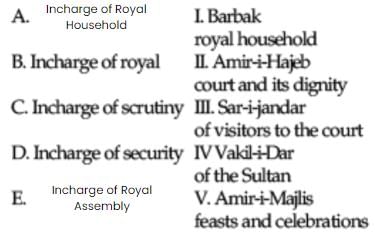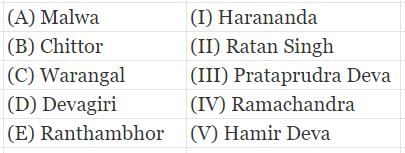Satish Chandra Test: The Delhi Sultanate- 2 - UPSC MCQ
30 Questions MCQ Test - Satish Chandra Test: The Delhi Sultanate- 2
Who was the first Caliph as well as the founder of the Umayyad dynasty of the Caliphate?
During the reign of which Delhi Sultan did the “Chahalgani” or “Chalisa’ come into existence?
Whom did Mahmud of Ghazni defeat to conquer and annex Peshawar and Punjab?
During Firuz Tughlaq’s long reign of 40 years, there was only one rebellion by a noble. Who was he?
Who was the court poet of Mahmud of Ghazni and author of Shah Namah?
During the Delhi Sultanate, the designation 'Muqaddam or Chaudhari' was used for
The historical works of which two historians of the Delhi Sultanate have Tarikh-i-Firuzshahi as their title?
I. Amir Khusrau
II. Minhas-us-Siraj
III. Ziauddin Barani
IV. Shams-i-Siraj Afif
Which one of the following statements about the nature of the Muslim state in India during the Sultanate period is not correct?
Name the Abbasid Caliph who probably conferred on Mahmud of Ghazni, the title of ‘Sultan’ for the first time in the Islamic history.
The recognition of Caliph’s authority by the Delhi sultans at the most meant
Which of the following is not correct ?
Which of the following statements is incorrect in connection with the political situation obtaining at the time of the accession of Iltutmish to the throne of Delhi ?
Which of the following is incorrect ?
The most serious sectarian conflict between the Sunnis and the Shias occurred during the reign of
Who was the only Indian Muslim to sit on the throne of Delhi during the Sultanate period?
What was the name of the Sultan who ascended the throne of Delhi after the death of Balban?
What the word ‘Khalji Revolution’ stands for?
Dr. Ishwari Prasad writes, “He always behaved like a well bred oriental monarch. His sense of kingly dignity was so great that he never ap-peared but in full dress ever before his private servants. He never laughed aloud nor joked in his durbar nor did he permit any one to indulge in laughter or amusement in his presence”. Who is that king?
Which one of the following sultans refused to speak to common people?
Which of the following regions of northern India was not included in the empire of Ala-ud-din Khalji?
What was the name of the south Indian ruler who defeated the army of Ala-ud-din Khalji in 1303?
Which sultan in order to forestall conspiracies banned banquets and assemblies and peppered the country with his spies?
What was the period of rule of Qutb-ud-din Aibak?
Which Sultan of Delhi introduced market control policies to regulate prices and prevent black marketing?
















